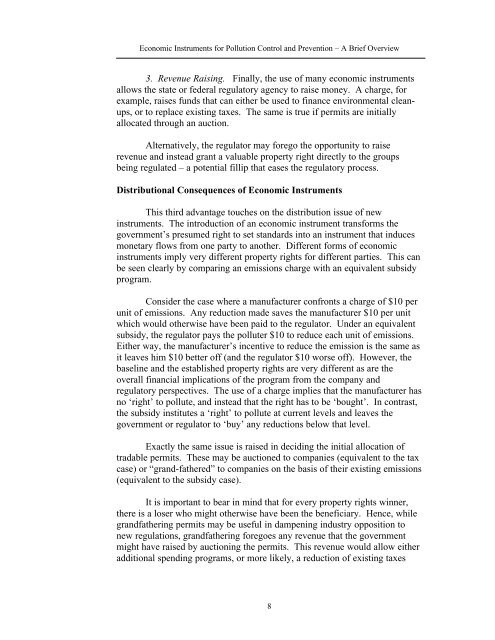Economic Instruments for Pollution Control and Prevention - World ...
Economic Instruments for Pollution Control and Prevention - World ...
Economic Instruments for Pollution Control and Prevention - World ...
Create successful ePaper yourself
Turn your PDF publications into a flip-book with our unique Google optimized e-Paper software.
<strong>Economic</strong> <strong>Instruments</strong> <strong>for</strong> <strong>Pollution</strong> <strong>Control</strong> <strong>and</strong> <strong>Prevention</strong> – A Brief Overview<br />
3. Revenue Raising. Finally, the use of many economic instruments<br />
allows the state or federal regulatory agency to raise money. A charge, <strong>for</strong><br />
example, raises funds that can either be used to finance environmental cleanups,<br />
or to replace existing taxes. The same is true if permits are initially<br />
allocated through an auction.<br />
Alternatively, the regulator may <strong>for</strong>ego the opportunity to raise<br />
revenue <strong>and</strong> instead grant a valuable property right directly to the groups<br />
being regulated – a potential fillip that eases the regulatory process.<br />
Distributional Consequences of <strong>Economic</strong> <strong>Instruments</strong><br />
This third advantage touches on the distribution issue of new<br />
instruments. The introduction of an economic instrument trans<strong>for</strong>ms the<br />
government’s presumed right to set st<strong>and</strong>ards into an instrument that induces<br />
monetary flows from one party to another. Different <strong>for</strong>ms of economic<br />
instruments imply very different property rights <strong>for</strong> different parties. This can<br />
be seen clearly by comparing an emissions charge with an equivalent subsidy<br />
program.<br />
Consider the case where a manufacturer confronts a charge of $10 per<br />
unit of emissions. Any reduction made saves the manufacturer $10 per unit<br />
which would otherwise have been paid to the regulator. Under an equivalent<br />
subsidy, the regulator pays the polluter $10 to reduce each unit of emissions.<br />
Either way, the manufacturer’s incentive to reduce the emission is the same as<br />
it leaves him $10 better off (<strong>and</strong> the regulator $10 worse off). However, the<br />
baseline <strong>and</strong> the established property rights are very different as are the<br />
overall financial implications of the program from the company <strong>and</strong><br />
regulatory perspectives. The use of a charge implies that the manufacturer has<br />
no ‘right’ to pollute, <strong>and</strong> instead that the right has to be ‘bought’. In contrast,<br />
the subsidy institutes a ‘right’ to pollute at current levels <strong>and</strong> leaves the<br />
government or regulator to ‘buy’ any reductions below that level.<br />
Exactly the same issue is raised in deciding the initial allocation of<br />
tradable permits. These may be auctioned to companies (equivalent to the tax<br />
case) or “gr<strong>and</strong>-fathered” to companies on the basis of their existing emissions<br />
(equivalent to the subsidy case).<br />
It is important to bear in mind that <strong>for</strong> every property rights winner,<br />
there is a loser who might otherwise have been the beneficiary. Hence, while<br />
gr<strong>and</strong>fathering permits may be useful in dampening industry opposition to<br />
new regulations, gr<strong>and</strong>fathering <strong>for</strong>egoes any revenue that the government<br />
might have raised by auctioning the permits. This revenue would allow either<br />
additional spending programs, or more likely, a reduction of existing taxes<br />
8

















